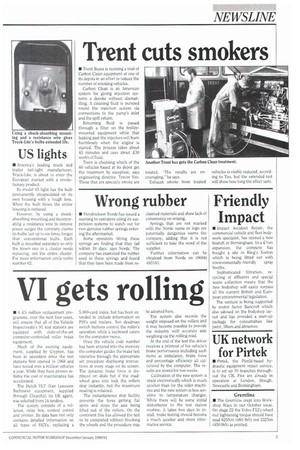VI gets rollin
Page 81

If you've noticed an error in this article please click here to report it so we can fix it.
• A 45 million replacement programme, over the next four years, will ensure that all of the Vehicle Inspectorate's 91 test stations are equipped with state-of-the-art computer-controlled roller brake equipment.
Much of the existing equipment, supplied by Crypton, has been in operation since the test stations first opened in 1968 and have tested over a million vehicles a year. While they have proven reliable the cost of maintenance has accelerated.
The Dutch VLT (Van Leeuwen Techniek) equipment, supplied through Churchill its UK agent, was selected from 14 tenders.
The system consists of a rollerset. relay box, control consol and printer. Its data base not only contains detailed information on all types of FICVs, replacing a 8,000-card index, but has been extended to include information on PSVs and trailers. Ten deadman switch buttons control the roller's operation while a keyboard caters for the computer menu.
Once the vehicle code number has been entered into the memory the computer guides the brake test operative through the appropriate set procedure displaying instructions at every stage on its screen. The dynamic brake force is displayed on dials but if the roadwheel goes into lock the rollers stop instantly, but the maximum reading is retained.
The instantaneous stop facility prevents the tyres getting flat spots and stops the axle being lifted out of the rollers. On the continent this has allowed the test to be completed without blocking the wheels and the procedure may be adopted here.
The system also records the weight imposed on the rollers and it may become possible to provide the industry with accurate axle weighing via the rolling road.
At the end of the test the driver receives a printout of his vehicle's brake performance including such items as imbalance, brake force and percentage efficiency all calculated by the computer. The results are stored for two weeks.
Calibration of the new system is made electronically which is much quicker than for the older machines and the new system is less sensitive to temperature changes. While there will be some initial disturbance to the test station routine, it takes two days to install, brake testing should become a much quicker and more informative service.












































































































